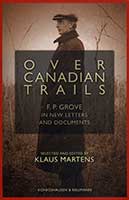by Doug Ramsey
Rural Development Department, Brandon University
|
Over Canadian Trails: F. P. Grove in New Letters and Documents, selected and edited by Klaus Martens Würzburg: Königshausen and Neumann GmbH, 2007, 662 pages. ISBN 9783826035968, € 58.00.
 Over Canadian Trails was a pleasure to read. The research behind the writing was a monumental task. The volume, while literary analysis, is also historical, geographical, and sociological. Telling someone’s story through letters, interviews and a host of other documents from financial ledgers, official registries to newspaper articles and literary announcements must have been daunting and is most certainly the result of many years of research. Klaus Martens certainly succeeded. At 662 pages, much of Grove’s adult life can now be examined in one volume. Martens frames the travels, trials and tribulations of F. P. Grove in six periods, roughly based on his geographic locations. The first chapter is devoted to Grove’s life prior to arriving in North America. While one of the shortest chapters, 72 pages to cover 30 years, Chapter 1 does the job of setting up the context of Grove as a writer, immigrant, and victim of friendship gone bad. The first he pursued throughout his adult life. The latter was an experience that carried on with his concerns over the publishing industry in Canada.
Over Canadian Trails was a pleasure to read. The research behind the writing was a monumental task. The volume, while literary analysis, is also historical, geographical, and sociological. Telling someone’s story through letters, interviews and a host of other documents from financial ledgers, official registries to newspaper articles and literary announcements must have been daunting and is most certainly the result of many years of research. Klaus Martens certainly succeeded. At 662 pages, much of Grove’s adult life can now be examined in one volume. Martens frames the travels, trials and tribulations of F. P. Grove in six periods, roughly based on his geographic locations. The first chapter is devoted to Grove’s life prior to arriving in North America. While one of the shortest chapters, 72 pages to cover 30 years, Chapter 1 does the job of setting up the context of Grove as a writer, immigrant, and victim of friendship gone bad. The first he pursued throughout his adult life. The latter was an experience that carried on with his concerns over the publishing industry in Canada.
Chapters Two to Six trace Grove’s life and travels, as resident and speaker, across Canada. What must be incredibly rewarding to Martens is that he was able to collect and assemble 300 pages of documents and commentary to describe only eight years of Grove’s life from 1922 to 1929 (Chapters Three and Four). Grove and his family struggled financially, as they did with Grove’s ill-health, during most of their lives in Canada. As noted by Martens at several points, Grove was trying to establish himself during troubled times (two world wars and the Great Depression) and when Canadian literature was still in its infancy.
One of the greatest strengths of Over Canadian Trails is that the correspondence is two-way. That is, Grove’s life is not documented only by letters received by Grove. The importance in this is not only providing a more complete story but also allows the reader to the opportunity to be part of Grove’s life. In particular, the correspondence between Grove and Phelps is noteworthy. At times the tone between them was terse, but each always expressed interest and concern for the other and their families. This correspondence also illustrates that Grove was not alone in struggling as a Canadian writer during this period. Also important are the letters between Grove and his wife during his lecture series across Canada after the death of their daughter. The letters are very matter of fact with Grove mostly signing off with “bye bye.”
Any criticisms of Over Canadian Trails are small. In reading some passages, the reader is unclear of the source and importance of the reference. In particular, there seems to be an unwritten assumption that the reader has read many of Grove’s works – and in particular In Search of Myself. While this would be a reasonable assumption, more commentary on the importance of the passages cited would have provided more of a story. However, at 662 pages, it is understandable why such commentary was kept to a minimum (perhaps like Grove’s experience, Martens faced page limits with his publisher!).
Another criticism is that some photos and other graphics do not seem to be placed where they are relevant to the text. This could have been resolved by labelling each as a Plate or Figure. Having said this, such actions could have detracted from its flow—and the story that Martens was telling. In fact, whether intentional or not, as presented the reader must be fully engaged in cross-referencing Martens’ commentary and analysis, the reproduced letters, and the other visual representations to understand Grove’s experiences. I found myself going back and forth for my own interest and in doing so uncovered gaps in letters, from or to Grove, such as between 1909 and 1917 (pp. 71-110). For readers wanting more, In Search of Myself by Grove is a must read. For those whose passions lie with the loss of Grove’s daughter, Phyllis May, A Dirge for My Daughter: Poems (selected and edited by Klaus Martens, Würzburg: Königshausen and Neumann GmbH, 2006) is a must read.
Taken together, Martens has assembled an eclectic, if not close to complete, volume of letters, passages, documents, and photographs. It will be interesting to see if its publication results in the emergence of “new” letters that families have stored away in attics across Canada. As a resident of Brandon, Manitoba whose hometown is Simcoe, Ontario, I will continue to follow the developments of Grove’s life in Canada. Perhaps, Over Canadian Trails will create a new wave of interest in Grove’s work. I hope that it does.
Page revised: 8 June 2014